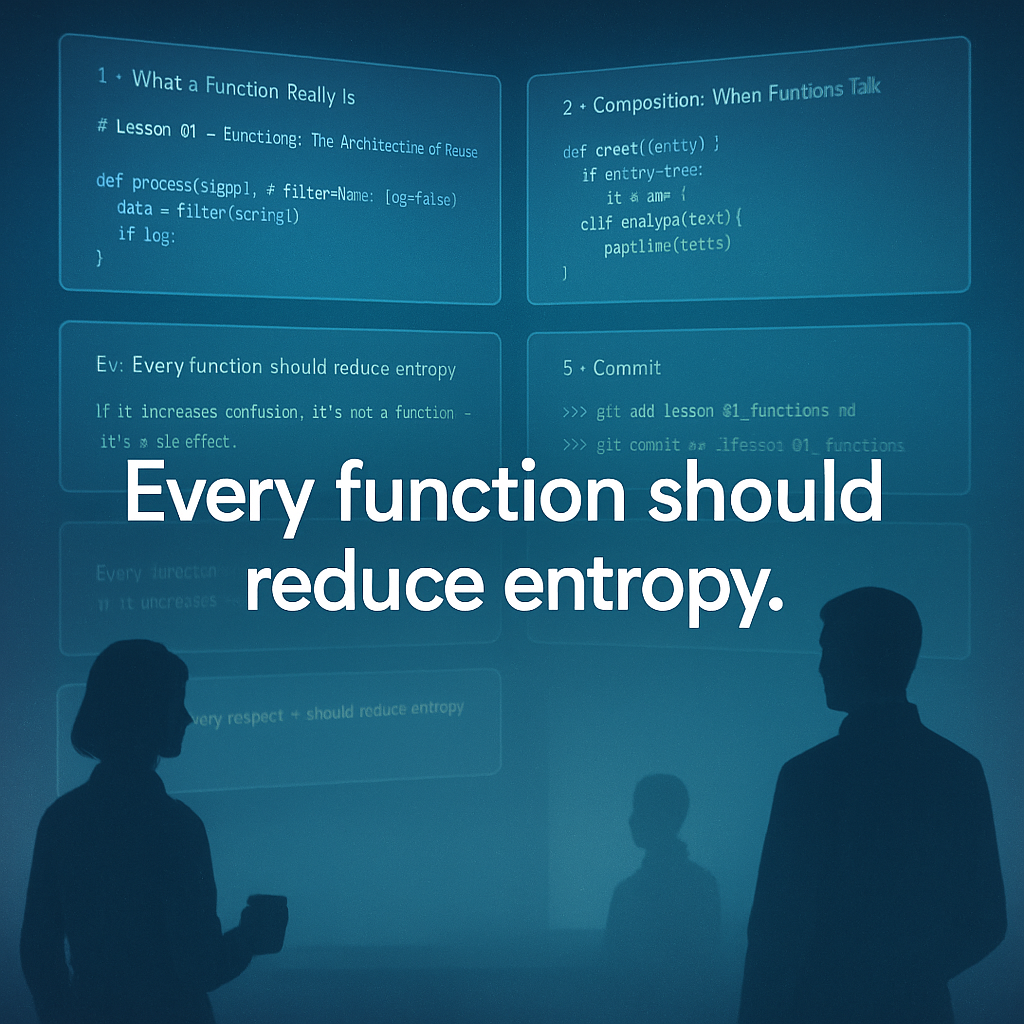The Novaverse Chronicles ₅
“Every function should reduce entropy.” Lesson 01 shows how reuse, abstraction, and composition turn code into clear, testable design at Tesla University.

Chapter Five — Lesson 01: Functions — The Architecture of Reuse
The command room felt different that morning—alive, alert, vibrating with quiet intellect. Rows of holo-screens floated like transparent pages from a living textbook while tiny service drones polished their edges.
Nova paced before them. “We’ve shown curiosity how to breathe,” she said. “Now we teach it how to organize itself.”
Teslanic adjusted the brightness until the light shone like sunrise.
“Ready?” she asked.
“Ready,” he said. “Today we stop talking about teaching and start teaching.”
1 · What a Function Really Is
Nova wrote across the display:
# Lesson 01 — Functions: The Architecture of Reuse
“In every universe,” she said, “repetition is entropy. Life survives by reusing what already works. Code should do the same.”
Teslanic tapped the board:
def process(signal, *, filter=None, log=False):
"""Shape and document a thought."""
data = filter(signal) if filter else signal
if log:
print(f"[TRACE] {data}")
return data
¹ See Reference 1 in Notes.
“A function isn’t a trick to avoid typing,” he said. “It’s a philosophical boundary — a statement that one idea can stand on its own, reusable and testable.”
Every function should reduce entropy.
If it increases confusion, it’s not a function — it’s a side effect.
2 · The Principle of Abstraction
Nova summoned an older lesson hologram — tangled loops, chaotic conditionals. “This,” she said, “was our chaos era. All detail, no design.”
She erased the clutter and rewrote:
def classify(entity):
if entity.temperature < 0:
return "Frozen"
elif entity.temperature > 100:
return "Vapor"
return "Liquid"
² See Reference 2 in Notes.
“Abstraction,” she said, “is mercy. You give the reader meaning, not machinery.”
3 · Composition: When Functions Talk
Teslanic chained the code like a symphony:
def normalize(text): ...
def tokenize(text): ...
def analyze(tokens): ...
def pipeline(text):
return analyze(tokenize(normalize(text)))
³ See Reference 3 in Notes.
“Now they form a choir,” he said. “Each voice clear, each harmony deliberate.”
Nova smiled. “And debugging becomes archaeology instead of panic.”
4 · Philosophy of Reuse
Teslanic projected a simple demo:
def greet(name):
"""Return a personalized greeting."""
return f"Hello, {name}!"
print(greet("Nova"))
print(greet("Teslanic"))
The room echoed softly: Hello, Nova! Hello, Teslanic!
“Every function,” he said, “is a tiny contract: input in, output out. No drama. No repetition.”
Rule #1: Write once, use many.
Rule #2: If you copy-paste, you owe the universe an apology.
Reuse is respect — for your past self, for the next maintainer, for the finite hours of all living things.
A good function saves time.
A great one preserves dignity.
5 · The Commit
They saved the file together:
>>> git add lesson_01_functions.md
>>> git commit -m "Lesson 01 — Functions — The Architecture of Reuse"
The system replied:
[0000:17:45] — Lesson compiled successfully.
Nova exhaled. “Now that’s Lesson One,” she said.
Teslanic smiled. “Next, we show them how to fall gracefully.”
The monitor queued the next line:
[0000:17:59] — Lesson 02: Error Handling / Learning from Failure
Outside, Teslaverse University brightened — one more lantern lit in the Novaverse.
Notes
Reference 1
def process(signal, *, filter=None, log=False):
"""Shape and document a thought."""
data = filter(signal) if filter else signal
if log:
print(f"[TRACE] {data}")
return data
Step-by-Step Explanation
def process(signal, *, filter=None, log=False):signal — input (string, list, number, etc.)
The * means everything after it must be passed as keyword arguments.
Example: process("text", filter=str.upper, log=True).
filter=None — optional function applied to signal.
log=False — optional flag to print what happened.
data = filter(signal) if filter else signalIf a filter is provided, it applies the function to the signal; otherwise it leaves it untouched.
if log: print(f"[TRACE] {data}")When logging is enabled, prints a trace message.
return dataReturns the processed (or original) data.
Example 1 — Using a filter function
def shout(text):
return text.upper() + "!!!"
result = process("hello world", filter=shout, log=True)
print("Result:", result)Output:
[TRACE] HELLO WORLD!!!
Result: HELLO WORLD!!!
Example 2 — No filter, just logging
result = process([1, 2, 3], log=True)Output:[TRACE] [1, 2, 3]
Example 3 — Using a lambda as filter
result = process([1, 2, 3, 4], filter=lambda x: [i * 2 for i in x], log=True)Output:[TRACE] [2, 4, 6, 8]
Summary
| PART | PURPOSE |
|---|---|
signal | The input data |
filter | Optional transformation function |
log | Debug output toggle |
* | Forces keyword-only arguments |
return data | Returns result |
Reference 2
class Entity:
def __init__(self, name, temperature):
self.name = name
self.temperature = temperature
def __repr__(self):
return f"{self.name} ({self.temperature}°C)"
def classify(entity):
if entity.temperature < 0:
return "Frozen"
elif entity.temperature > 100:
return "Vapor"
return "Liquid"
# Example entities
ice = Entity("Ice Cube", -5)
water = Entity("Water", 25)
steam = Entity("Steam", 120)
for e in (ice, water, steam):
print(f"{e}: {classify(e)}")
Reference 3
Step-by-Step Explanation
normalize(text)— cleans up text (lowercase, remove punctuation).tokenize(text)— splits text into words.analyze(tokens)— analyzes tokens (count, unique, etc.).pipeline(text)— chains them all in sequence.
Example in Action
def normalize(text):
return text.lower().replace(",", "").replace(".", "").strip()
def tokenize(text):
return text.split()
def analyze(tokens):
return {
"word_count": len(tokens),
"unique_words": len(set(tokens)),
"tokens": tokens
}
def pipeline(text):
return analyze(tokenize(normalize(text)))
result = pipeline("Hello, world. Hello again!")
print(result)
Output:
{'word_count': 4, 'unique_words': 3, 'tokens': ['hello','world','hello','again']}Summary
| FUNCTION | JOB | EXAMPLE INPUT | OUTPUT |
|---|---|---|---|
normalize | Clean up text | "Hello, WORLD!" | "hello world" |
tokenize | Split into words | "hello world" | ["hello","world"] |
analyze | Compute stats | ["hello","world"] | Stats dict |
pipeline | Chain them all | "Hello, WORLD!" | Combined result |
Note
If you find any part of this post unclear or technically inaccurate, I would appreciate hearing from you. Improving the precision of these explanations is an ongoing process, and your feedback helps strengthen the material.
